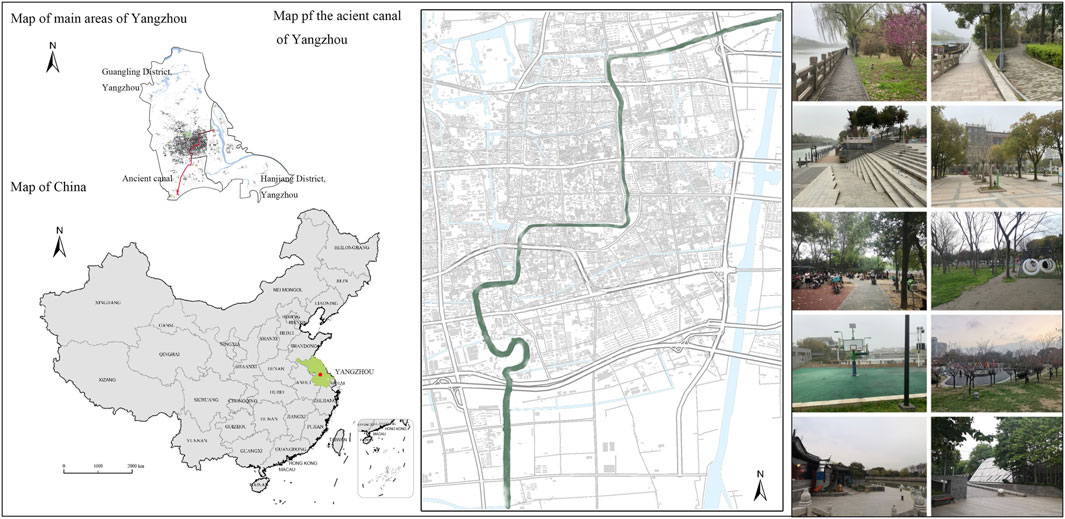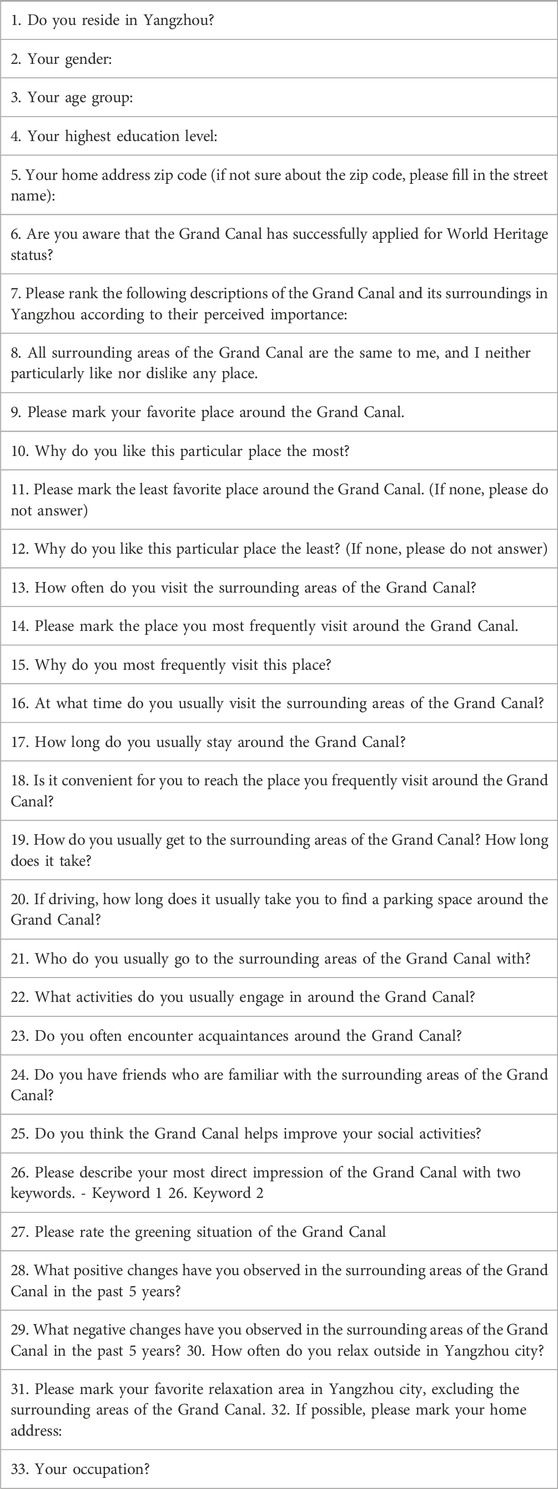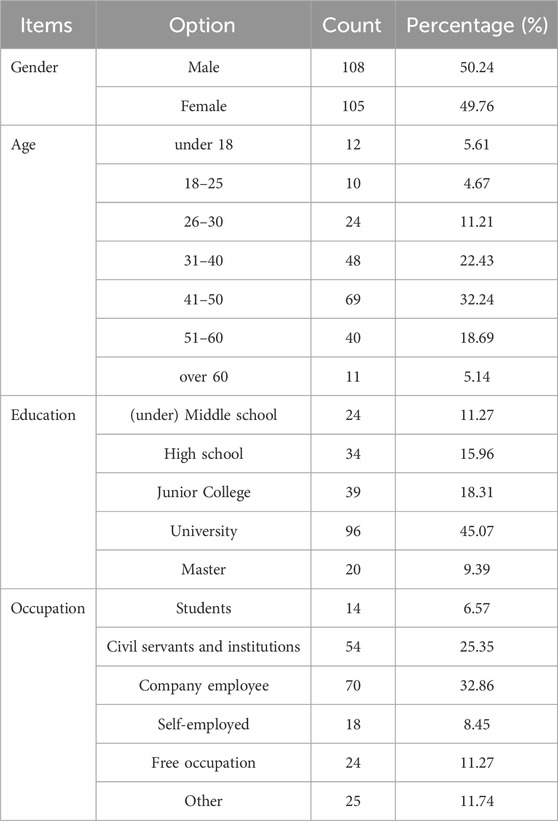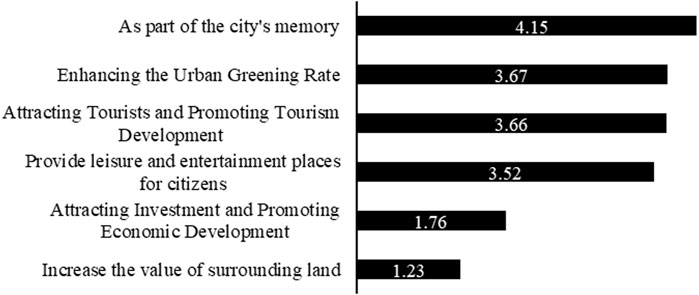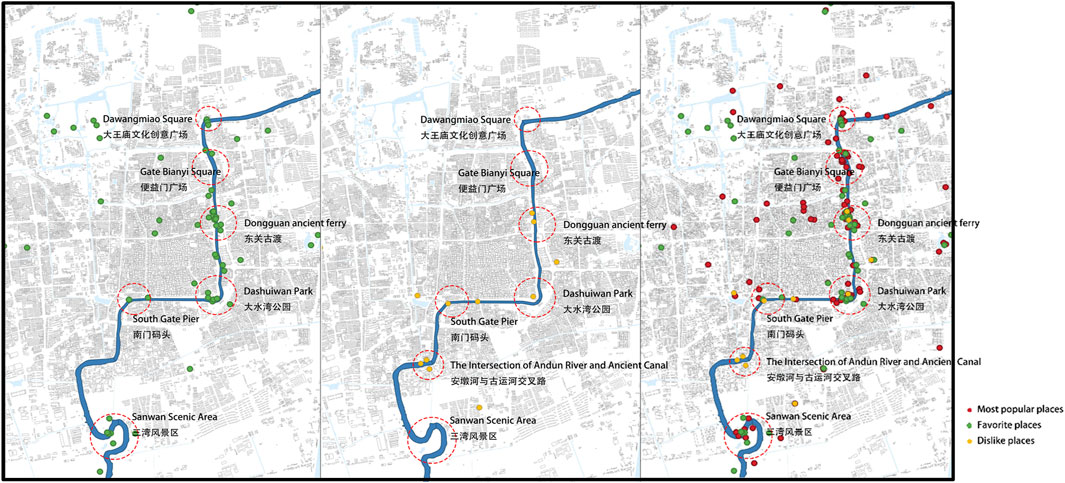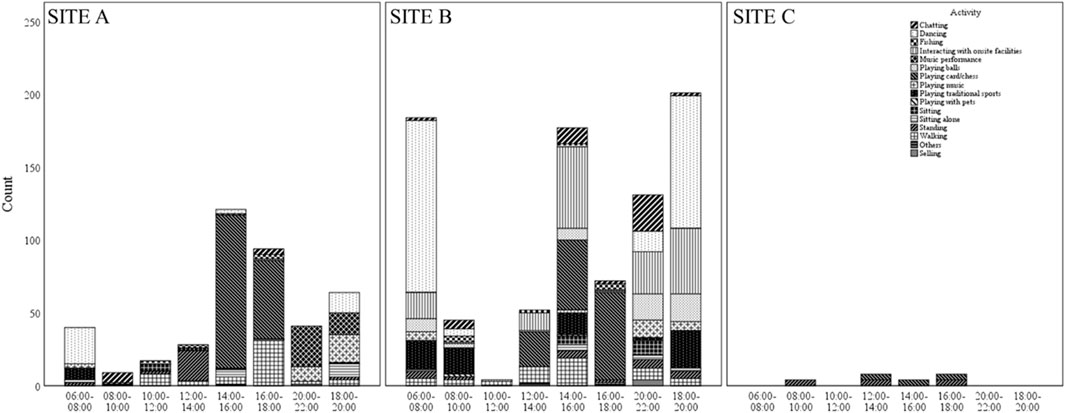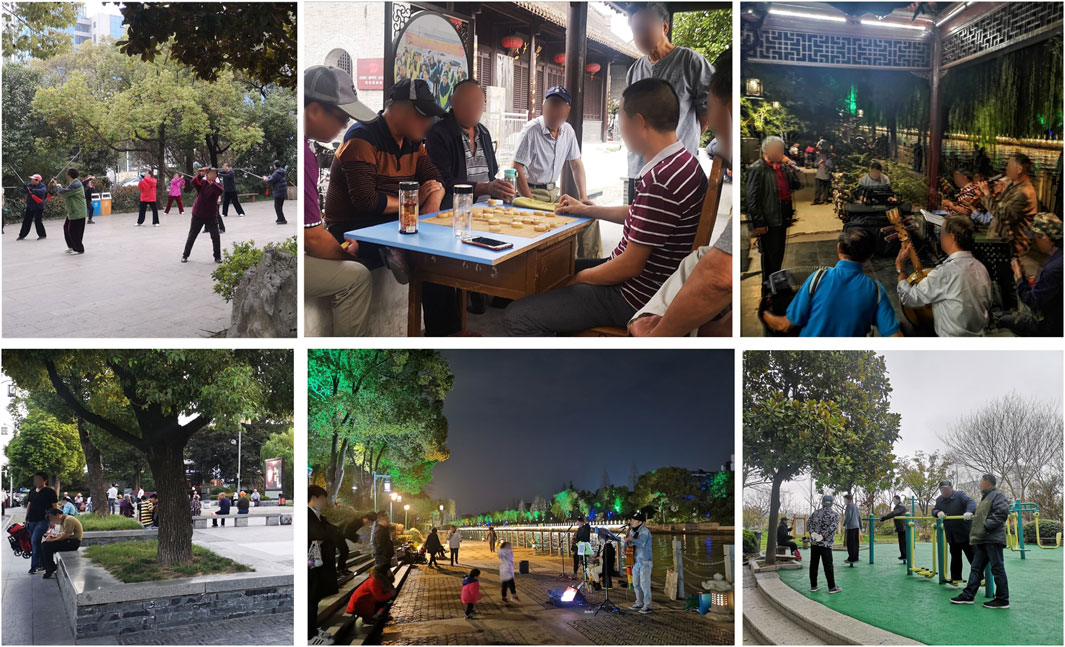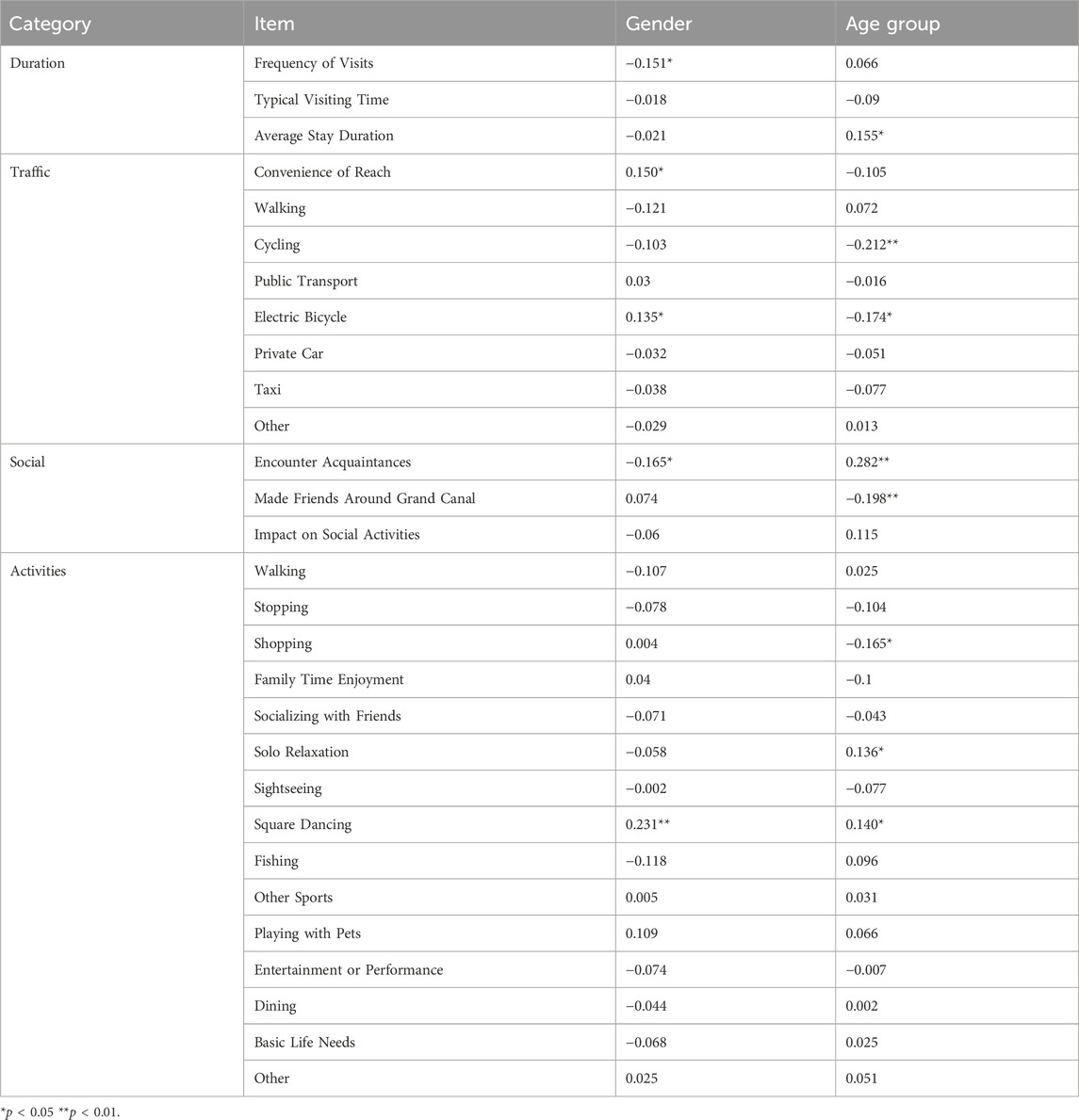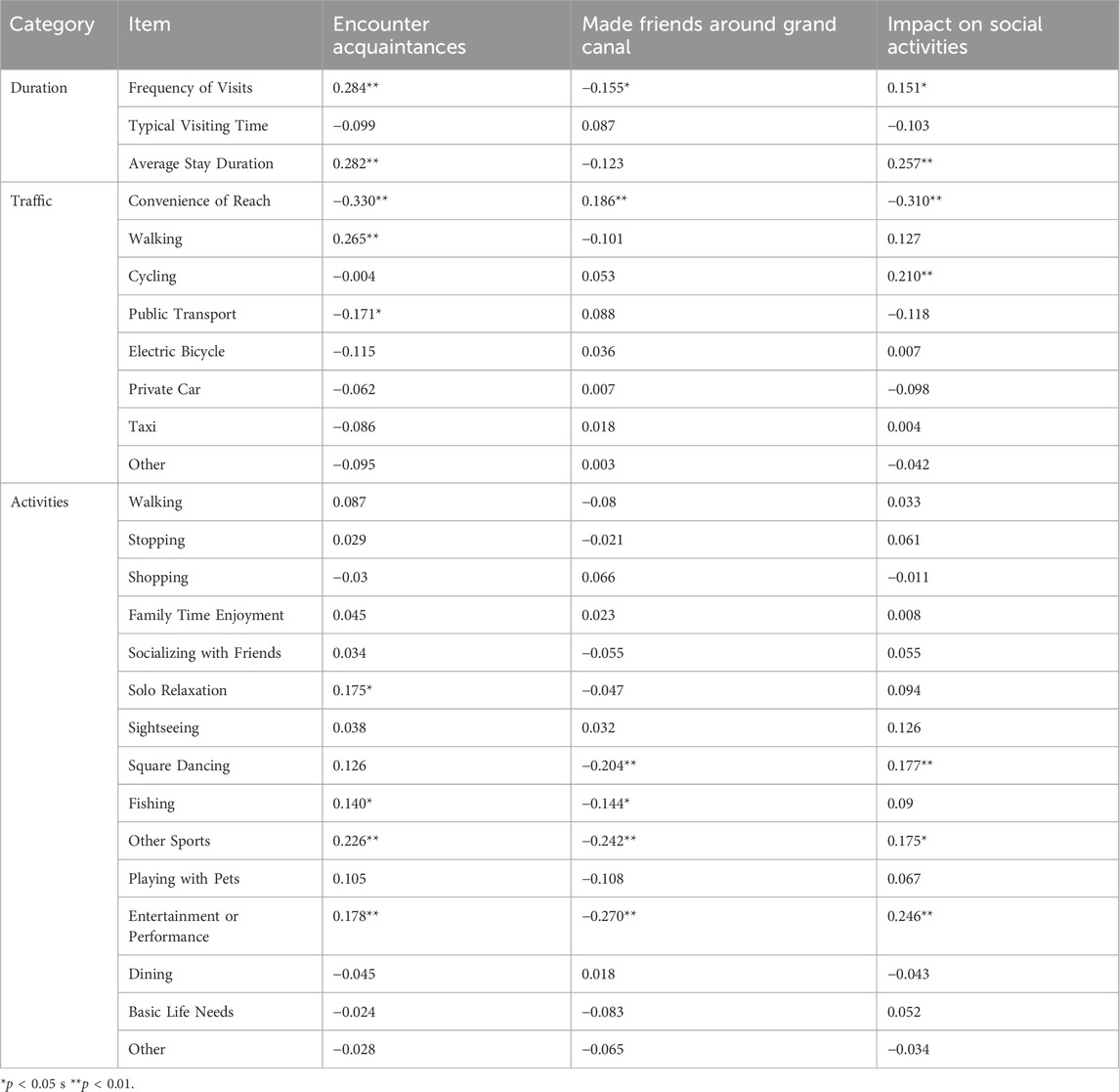- 1Department of Architecture, Built Environment and Construction Engineering, Polytechnic of Milan, Milano, Italy
- 2Department of Architecture, University of Bologna, Bologna, Italy
This study applies transformative technologies, specifically Geographic Information Systems (GIS) and environmental psychology tools, within the Yangzhou Canal area, enhancing public space utility and resident satisfaction. Using a mixed-methods approach, including a survey with 213 responses and field observations, we explored the socio-psychological impacts of the canal as a historic urban landscape. Questionnaire responses revealed correlations between the spatial characteristics and their usage, perceived and actual uses of space, exploring the canal’s cultural value, visiting methods and temporality, social and spatial characterization, and the residents’ preferences for different canal spaces. Observational studies at three key sites highlighted distinct patterns in activity and engagement, offering insights into locals’ preferences and behaviors. The findings contribute to urban design by providing a research framework that integrates historical canals with contemporary urban life, ultimately enhancing community satisfaction and livability. This study introduces a novel approach by systematically implementing GIS and environmental psychology to analyze and improve public spaces.
1 Introduction
In the recent past, the offer of products and services started to link to the emotional sphere of the customer, giving rise to the so-called Experience Economy, retaining that experience to constitute a specific economic proposal. The idea of experience as a competitive lever is also introduced by those who believe that in order to differentiate goods it is no longer sufficient to increase their benefits. Still, it is essential to offer the consumer an emotion: experiences “provide sensory, emotional, cognitive, behavioral and relational values” (Schmitt, 1999). Today it is believed that the Experience Economy has run its course, giving way to the Transformation Economy where “the basis of success will lie in understanding the aspirations of individual consumers and businesses and guiding them to achieve these aspirations fully” (Pine and Gilmore, 1999).
At the basis of both approaches, the concept of experience is always present. In the Experience Economy, one activity must be “unforgettable,” if not “extraordinary,” in order to bring into play all the five senses of the consumer, following hedonistic and utilitarian motivations. This idea dates back to the eighteenth-century European romantic ideal, where “a way of life that favors change, diversity, and imagination is manifested. Romanticism is “associated with the search for intense pleasures and states high arousal in opposition to the mediocrity of everyday life” (Carù and Cova, 2003).
With the Transformation Economy, individual aspirations must first be understood before determining any change (physical, emotional, cognitive or spiritual), because the subject asks to be “changed”. “The offer is neither the materials it uses nor the physical goods it produces or the processes but the individual.” (Pine and Gilmore, 1999).
Experiences generally present two dimensions (Gaggioli et al., 2014): the epistemic dimension and the personal dimension. Transformative experiences of an epistemic nature allow the actively involved individual to obtain new knowledge through structured narratives and symbolic-metaphorical situations. Experiences of a personal nature, however, modify the person’s self; that is, they induce emotions that modify the values, priorities, and self-perception of the self.
Transformative experiences, by their nature, cannot be constructed, but only solicited through experiences that can be traced back to the following categories (Pine and Gilmore, 1999): entertainment experiences, which help to modify our vision of the world; educational experiences, which guide how we integrate into the surrounding world; escape experiences, which elevate our personal characteristics to new levels; and aesthetic experiences, which inspire a sense of wonder and beauty.
The term Transformative Design refers to an approach to design that aims to trigger significant and positive changes in society (Papanek, 1972; Ostanel, 2018). Applying this design practice to the built environment is of particular interest as cities are more than ever involved in complex urban regeneration interventions. This term refers to a particular category of intervention on buildings that aims to combine urban physicality (including the conservation and enhancement of heritage) with the economic and social dynamics that can encourage the production of new value.
The driving force of this combination is represented by the urban reactivation process (Fanzini and Venturini, 2022), whose aim is precisely to activate contextual resources (living and inanimate) to produce large and long-term socio-spatial effects. Manzini (2018) identifies these changes with the term “transformative social innovation”, that is, a form of innovation that arises and develops when a group of people, be they citizens, administrators or investors, propose new methods of intervention by combining the resources available with innovative practices, and in doing so they change the meaning of places and ways of doing things. The consequences bring with them behavioral change in people: by actively involving the recipients of the reactivation interventions, not only does the quality of the result improve in terms of compliance with the explicit needs of the project, but dynamics are triggered that make people more aware and responsible.
The characteristics of transformative design mainly concern the articulated and complex dimension of the problems that must be addressed, as well as the operational methods necessarily based on the flexibility and adaptability of the processes, inclusiveness of the interested parties, measurability of the impacts to encourage an effective analytical evaluation of the different implementation possibilities and, last but not least, the effectual and effective collaboration between the subjects involved which goes beyond disciplinary barriers, as well as intellectual abilities.
A design practice of this nature cannot be traced back to standard processes and methods that are valid once and for all. We talk about shared policies and strategies, participation, and co-design, that is, forms of design that involve ordinary people, also and above all to parameterize the perceptive link between the future users of the project and the nature of the places and, in doing so lay the foundations for a qualitative-quantitative verification of the interaction.
A particular push for the development of this disciplinary area is linked to the contributions of environmental psychology, understood as a “subfield of psychology that studies the interplay between individuals and the built and natural environment.” This specific relation intersects significantly with the concept of the extended mind (Clark and Chalmers, 1998) in architecture and urban design. This theory postulates that objects and spaces in our environment become extensions of our cognitive processes, offering a lens through which it is possible to assess the environment’s role in the cognitive life of its users. The research of William H. Whyte’ and Jan Gehl examines public life in public space based on direct observation and pays attention to how public space could encourage positive activities from the angle of behavioral psychology.
The field of research known as “psychology of the built environment” focuses on how people react to their immediate surroundings and how they might best choose, improve, and create a habitat that supports their physical and mental wellbeing. The real built environment serves as a stimulus condition to which people respond, prompting them to think, plan, and act; these mental processes and actions, in turn, serve as the basis for evaluating the built environment. The conclusions of this evaluation can be used as a reliable basis for architectural or environmental design since they shed light on architectural environmental psychology. Architectural psychologists’ fundamental concern is how built environments influence individual behavior and mental state. According to the preceding research themes, the psychological analysis of the built environment consists of three layers.
1. Between mental and behavior: it focuses on the interaction between the fundamental mental functions of people and the built environment. At this level, the psychology of the built environment focuses on the psychological experience of the visual, auditory, and olfactory perceptual channels brought about by the color, light, material, and form of the built environment.
2. Consciousness layer: to investigate the connection between higher mental activity (such as human values, worldview, and aesthetics) and the constructed environment. The subject of the study is the individual’s perception and pursuit of the built environment as influenced by diverse values, worldviews, and aesthetics.
3. Behavior layer: to investigate the relationship between human behavior and the built environment, to examine the scale of interaction and habitual behavior, as well as the sense of domain and privacy of the built environment, and to investigate the comfort of the built environment in conjunction with ergonomics.
Another important contribution to the argument comes from Lynch (1964) studied on how each person perceives urban space. In describing the dimensions of the city, Lynch also proposes five elements: “vitality, sense, fit, access, and control”. According to Lynch, any city or settlement can be evaluated using these five dimensions.
1. Vitality: describes the support of spatial form for the fundamental needs of people and is a kind of protection for human survival. In Lynch’s words, this is an “anthropocentric criterion”.
2. Sense: describes the degree to which a spatial settlement can be clearly identified. This level of recognition becomes a structure that supports both the surrounding environment and subjective perception. It is worth mentioning that the content of City Image is mainly contained in this dimension.
3. Fit: refers to the extent to which the form and capacity of a space can be adapted to its users and meet their needs. It includes not only its present needs, but also those of the future.
4. Access: refers to the accessibility of a space to other people, activities, resources, information and services–both quantitatively and in terms of diversity.
5. Control: which reflects the control that the users of the space have over the activities in the space, which includes the creation, maintenance and management of those activities. In addition to these five dimensions, Lynch added two “upper dimensions”: efficiency and justice, the latter to balance the criteria for access and the former to balance the criteria for access to diverse values.
6. Efficiency relates to the cost of achieving the characteristics listed above.
7. Justice refers to whether or not each user receives benefits in accordance with the principle of justice.
This article employs the Ancient Canal of Yangzhou in China as a case study to investigate the dual challenges of urban canals as urban historic landscaping and urban public spaces adapting to contemporary urban life. The Ancient Canal is not just a remnant of the past but a vibrant part of the city’s urban fabric, playing a crucial role in the everyday lives of its residents. It provides a unique blend of cultural heritage and public utility, making it an ideal subject for studying the application of transformative design principles in urban spaces. The extended mind theory posits that objects and spaces in our environment can become extensions of our cognition, not merely backdrops but active participants in our mental processes (Clark and Chalmers, 1998). This theoretical perspective informs the study’s approach to the Ancient Canal, proposing that the design of urban spaces can significantly affect the cognitive and emotional experiences of individuals, enhancing their quality of life and wellbeing. This study employs a novel, evidence-based framework to explore how GIS and environmental psychology can be applied to enhance both the utility and the resident satisfaction of historic urban landscape like the canal.
2 Aims and objectives of the analysis
Urban canals often carry recreational, social and cultural significance, playing a vital role in shaping the dynamics of city life (Tsukada et al., 2014; Nicholls and Crompton, 2017; Vaeztavakoli et al., 2018; Lin et al., 2020). Moreover, it is vital for urban planners and designers to understand whether these spaces meet the complex needs of urban residents, encompassing both everyday life and social significance. This understanding, therefore, forms the cornerstone key to developing holistic strategies in urban design, pivoting towards inclusive and participatory solutions that integrate residents’ experiences and perceptions. From a social standpoint, the role of the canal refers to the identity, which is the “uniqueness” of an object from various (i.e., personal, social, ethical, and even political) perspectives and goals (Kaymaz, 2013). Identity is an interpretation of the unique characteristics of a territory or a mixture of the individuals as a comprehensive subject (Ujang, 2012). Through the concept of place role or identity, one explores what a place genuinely looks like and which common aspects influence the perceptions of each observer. Recognizing these distinctive physical and/or visual characteristics can aid in additional evaluations of the identity of a place (de Magalhães and Carmona, 2009).
In light of these considerations, these aims are pursued through research predicated on elucidating the influence of canal spaces on resident behaviors, socialization, and satisfaction within urban contexts. The research endeavors to specifically investigate the perceptions of urban residents towards canal spaces and their consequential effects on daily life, aiming to provide insights for urban planning and design. This endeavor necessitates ensuring urban waterfront areas meet environmental demands while also fulfilling the social and cultural expectations of the community. In this regard, the study focuses on a comprehensive case analysis of the ancient canal in Yangzhou, pursuing dual objectives. Namely, the primary goal is to delineate and examine the critical factors contributing to resident satisfaction related to urban canal spaces, emphasizing the synergy between historical appreciation and contemporary usage. The secondary objective is to contextualize these findings within the setting of the Yangzhou Ancient Canal, assessing its impact on local residents’ perceptions, activities, social engagements, and overall contentment.
To achieve its objectives, the study employed a mixed-methods approach, integrating quantitative and qualitative data to comprehensively understand the canal’s impact on urban life. Quantitative data was collected through a structured questionnaire survey that gathered residents’ satisfaction (Haruna et al., 2023) of the ancient canal, inquiring about awareness of the history of the ancient canal, traffic issues, and social opportunities. In parallel, qualitative insights were derived from field observations, which allowed for an in-depth exploration of the canal’s role in daily activities and social interactions. This mixed-methods approach enables data triangulation, strengthening the validity of the results and providing a rich contextual analysis that supports the development of impactful urban design solutions. Subsequently, a selection of results was visualized using Geographic Information Systems (GIS) to create intuitive maps for analyzing pertinent locations. Similar applications of GIS have proven effective in enhancing safety and walkability in historic public spaces in Libya (Abdulla and Abdelmonem, 2023). Furthermore, typical ancient canal locations identified from questionnaire outcomes were subject to temporal observational studies, documenting people’s activities within the canal area throughout the day. These results aim to uncover patterns and correlations that could inform urban design strategies. This amalgamation of methods offers a comprehensive understanding of the role of the urban canal in enhancing the quality of urban life.
3 Methodology of the contextual analysis
The study, conducted in Yangzhou City, Jiangsu Province, China, explores the unique urban landscape shaped by its historical and contemporary relationship with the ancient canal. Yangzhou, an important city along the China Grand Canal, is home to approximately 4,508,200 people. The ancient canal in the city center is a significant part of the China Grand Canal heritage area, forming a semi-circular boundary around a historic district of about 13 square kilometers (Figure 1). This area, rich in historical layers, continues to be Yangzhou’s urban center. The ancient canal is a historical relic and a vital component of the city’s structure, influencing Yangzhou’s spatial layout and social dynamics. Its presence has intertwined the city’s historical heritage with modern urban living.
In the context of Yangzhou’s urban development, the “Master Plan of Yangzhou City (2011–2020)” recognizes the city’s abundant water system as a pivotal element in the development of urban public open spaces. Aligning with this vision, the plan emphasizes the enhancement of the city’s waterways, particularly through the creation of belt parks along the ancient canal and the China Grand Canal. These proposed parks aim to establish a green corridor traversing the city from north to south, integrating natural beauty with urban development. The corridor’s two main belt parks, the ancient canal riverside belt park and the Chenghe belt park, are designed with a tiered approach to urban landscaping. They are categorized into three levels of control based on their proximity to the river. This stratification reflects a nuanced understanding of the interaction between urban spaces and bodies of water, allowing for a gradation of recreational, ecological, and aesthetic experiences along the water’s edge.
Within this context of the case study’s historic urban district, which encompasses diverse functions including leisure, sports, entertainment, cultural activities, and residential living, mapping the scope of resident activities introduces significant complexity, particularly due to the inherent temporal variations. Thus, through a specific questionnaire and field observations (Figure 2), real-time activities and behaviors have been documented in key canal areas identified as significant by survey respondents. Observations took place from 6:00 a.m. to 10:00 p.m., capturing daily variations in canal usage. Data collection occurred bi-hourly, ensuring a detailed temporal snapshot of human interactions with the canal spaces. This thorough approach provides a comprehensive understanding of the temporal dynamics. Furthermore, this study component was carried out from March 15th to 21 March 2021, focusing on sites with the highest reported value or contention among participants.
The structured questionnaire survey served as the foundation for collecting comprehensive data on the impact of urban canal spaces on residents’ satisfaction and engagement. Recognizing the varied demographic makeup of the urban population and the potential digital divide, especially among older individuals less accustomed to using smartphones, the survey was administered in paper format and online. By adopting this dual approach, the study ensured broader participation and representation. The questionnaire content spanned demographic information, the significance of urban canals, preferred and least preferred canal locations, and the frequency of canal visitation. This comprehensive approach enabled a holistic assessment of residents’ perceptions and behaviors. This survey phase was conducted in September 2019, with a random sample of 261 respondents in Yangzhou, yielding 213 statistically valid responses, 109 of which provided precise location data.
The questionnaire (Table 1) was meticulously formulated to cover a broad range of topics crucial for understanding the multifaceted relationship between residents and the canal. These included demographic details, awareness of the canal’s World Heritage status, the canal’s perceived roles, spatial preferences along the canal, visitation patterns, transportation modalities to canal areas, and the nature of social interactions in the ancient canal area. By encompassing these diverse aspects, the questionnaire comprehensively explored residents’ experiences and perspectives. Moreover, the questionnaire was structured to elicit both quantitative data through close-ended questions and qualitative insights via open-ended responses, thereby enabling a comprehensive analysis.
This study employs a blend of statistical graphs and distribution maps to dissect and display the gathered data. Adhering to the recommendations of the Historic Urban Landscape (HUL) approach by UNESCO (U.N.E.S.C.O., 2011) This paper leverages a GIS-supported spatial approach, which emphasizes the importance of conducting thorough surveys and mapping a city’s natural, cultural, and human resources. This methodology facilitates the visual representation of data collected from the research sites using QGIS software, allowing for a nuanced understanding of urban spaces.
For survey questions that provided multiple-choice answers, a weighted scoring system was applied to evaluate the responses. This methodological approach ensures a comprehensive assessment of the options. Each option was assigned a weight based on its ranking by the respondents. The formula for calculating the score is:
The final results are the average comprehensive score of each option, which reflects the options’ comprehensive ranking.
4 Results and analysis
A total of 213 (Table 2) respondents participated in the survey, with a nearly equal distribution between males (50.7%) and females (49.3%). The age group of 31–50 years old represented the largest share, accounting for approximately 66.46% of all respondents, with those aged 41–50 years old making up the highest proportion at 31.92%. The age groups below 18 and above 60 were less represented, comprising 5.63% and 5.16% of the sample, respectively. The age distribution between 26 and 60 years old was relatively balanced, ranging from 11.27% to 18.78%. Regarding educational background, individuals with an undergraduate degree constituted the majority, holding a 45.07% share, followed by those with an associate degree at 18.31%. The proportions of respondents with a high school/diploma or a postgraduate degree and above were comparatively lower, at 15.96% and 9.39%, respectively. Those with junior high school education or less were the least represented, accounting for 11.27%. Overall, the survey indicated a predominance of respondents with undergraduate education, representing the highest percentage.
4.1 The results of the questionnaire
The answers of the interviewees made it possible to determine interesting correlations between the characteristics of the spaces and the way in which they are used starting from their perception. The results of the analysis will be analyzed below to identify: basic knowledge of the context, its role, and cultural value; the people’s preference levels for different sections of the Canal; the methods of visiting and using the spaces along the canal by visitors; - the accessibility of the spaces and frequency of visits to them; the social characterization of the visit in relation to the characteristics of the spaces.
Regarding awareness of the Grand Canal’s successful designation as a World Heritage site, the survey reveals a diverse level of familiarity among respondents: four individuals (1.88%) have never heard of it, 99 respondents (46.48%) are aware but unclear on specifics, 87 individuals (40.85%) have a moderate understanding, and 23 respondents (10.8%) are very knowledgeable and have participated in related activities. These findings indicate that while the Grand Canal’s World Heritage status is widely recognized among the surveyed population, in-depth knowledge and engagement are relatively limited.
Moreover, cross (chi-square) analysis reveals significant differences in the sample regarding gender and age, with a higher proportion of males (82.61%) and individuals aged 31 and above opting for “Highly knowledgeable with involvement.”
Data from the illustrative scenario involving the Yangzhou ancient canal and its environs elucidates the comprehensive preferences of respondents. The outcomes (Figure 3) reveal a prioritization of the canal’s role as part of the city’s history, with the highest composite score of 4.15, followed by its contribution to enhancing urban greenery at 3.67, with the ability to attract tourists and foster tourism development closely behind at 3.66. The provision of leisure and entertainment venues for city residents was also valued, with a score of 3.52. In contrast, aspects related to attracting investment promoting economic development, and elevating the value of surrounding lands, notably through increased housing prices, were assigned lower priority, scoring 1.76 and 1.23, respectively.
Table 3 presents the cross (chi-square) analysis results, a statistical test used to determine the independence of categorical variables, between gender, age, education, and the question, “Do you know that the Grand Canal has been inscribed on the UNESCO World Heritage List?” A majority of 54.46% of respondents agree with the statement, “The areas surrounding the ancient canal are all the same to me; I have no particular likes or dislikes,” while 45.54% disagree, indicating a division in perceptions regarding the ancient canal’s surrounding areas. However, it is evident that a slightly larger portion of the population maintains a neutral stance towards these regions.
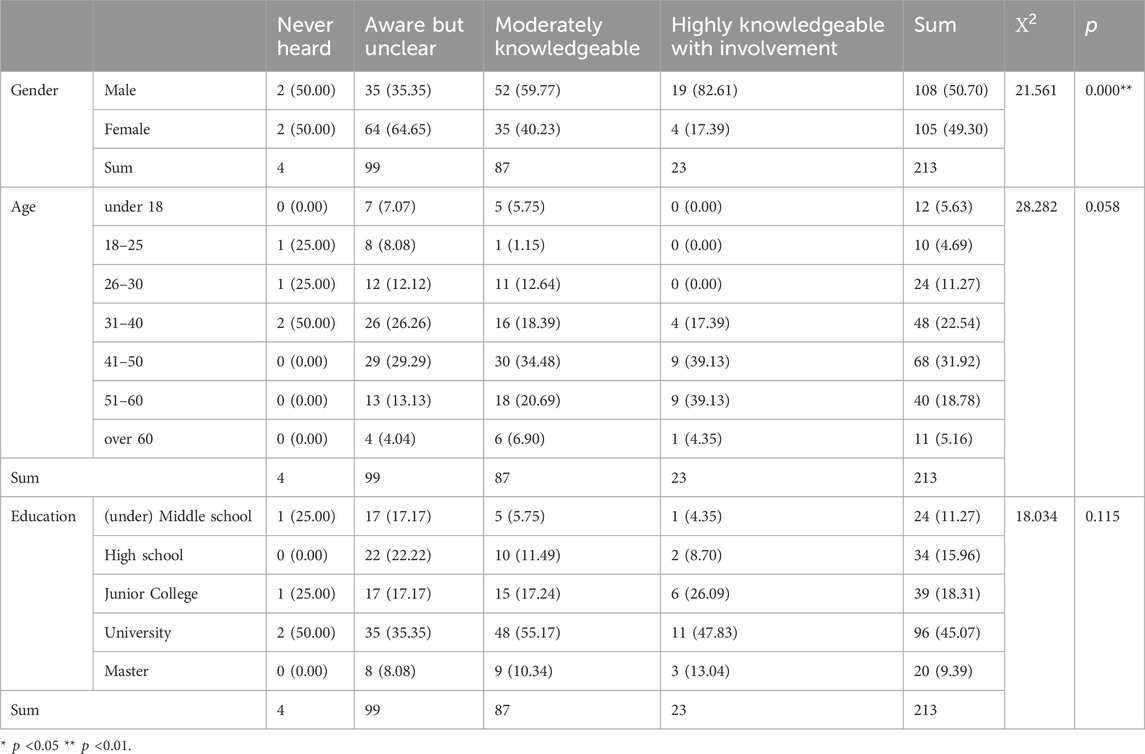
Table 3. Cross (chi-square) analysis between gender, age, education and the question “do you know that the Grand Canal has been inscribed in UNESCO?” (%).
The spatial analysis of preferences for urban canal spaces (Figure 4), as indicated by the survey results, reveals a complex pattern of likes and dislikes among residents. In the study, 97 respondents pinpointed their favored locations along the ancient canal, while 20 respondents indicated areas they disliked. The map overlays these preferences with residential addresses, providing a geographic context to the sentiments expressed.
Notably, five localities—Dawangmiao Square, Gate Bianyi, Dongguan Ancient Ferry, Dashuiwan Park, Southern Gate Pier, and Sanwan Scenic Area—emerge as the most endorsed by residents. Interestingly, there is an overlap in preferences, with three sites—Dongguan Ancient Ferry, Dashuiwan Park, and Southern Gate Pier—appearing among both the most liked and the most disliked, suggesting a nuanced reception of these spaces. Additionally, the Intersection Andu River and Ancient Canal is identified as a less favored location.
Complementing the spatial data, the analysis of the word clouds (Figure 5) offers insight into the broader public perception of the urban space. Cloud (a) encapsulates the positive sentiment, highlighting the area’s environmental quality and historical value with terms such as “scenery” and “memory.” In contrast, cloud (b) captures the negative viewpoints, with dominant themes of “pollution” and “crowd” pointing to perceived environmental degradation and overcrowding. These contrasting perspectives underscore a polarized perception of the urban canal space within the community. Figure 6A presents the correlation between residential locations and frequency of visits to the ancient canal, Figure 6B the correlation between residential locations and travel mode.
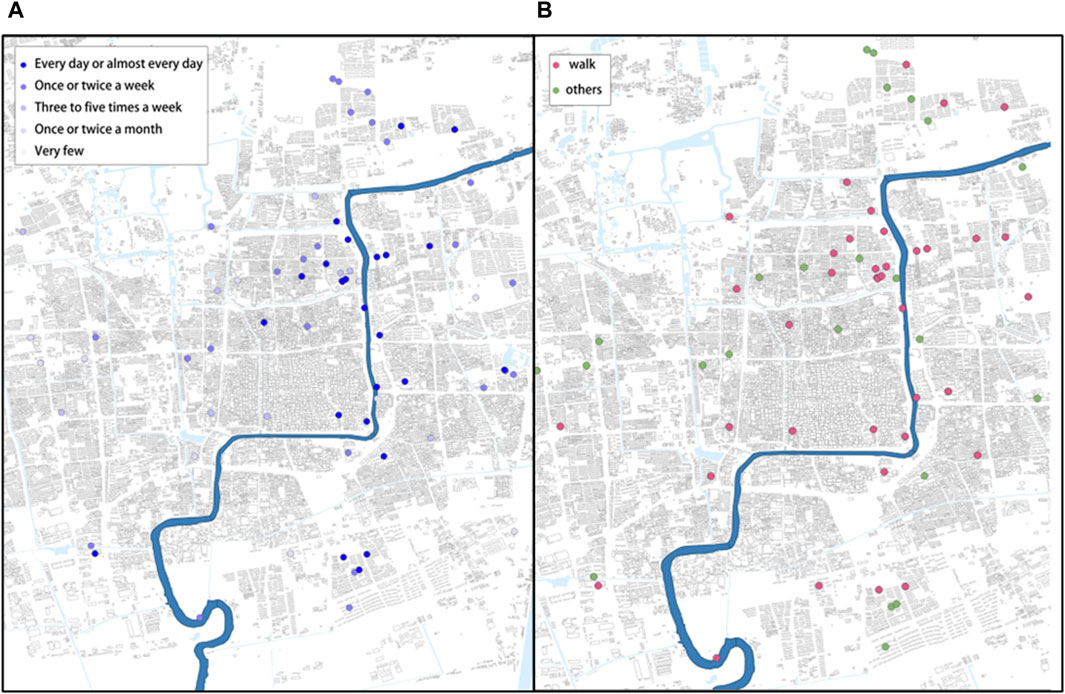
Figure 6. Correlation between residential locations and (A) frequency of visits to the ancient canal, (B) and travel mode among 109 respondents.
Figure 7 presents survey responses on the frequency of issues and activities associated with Urban Canal Spaces. The graph categorizes responses into four main areas: Temporal Issues, Traffic Issues, Social Issues, and Activities. The vertical axis represents the frequency percentage of each response, while the horizontal axis lists the survey questions corresponding to each category. Data highlights the public’s perceived problems and engagement levels in activities at urban canal spaces.
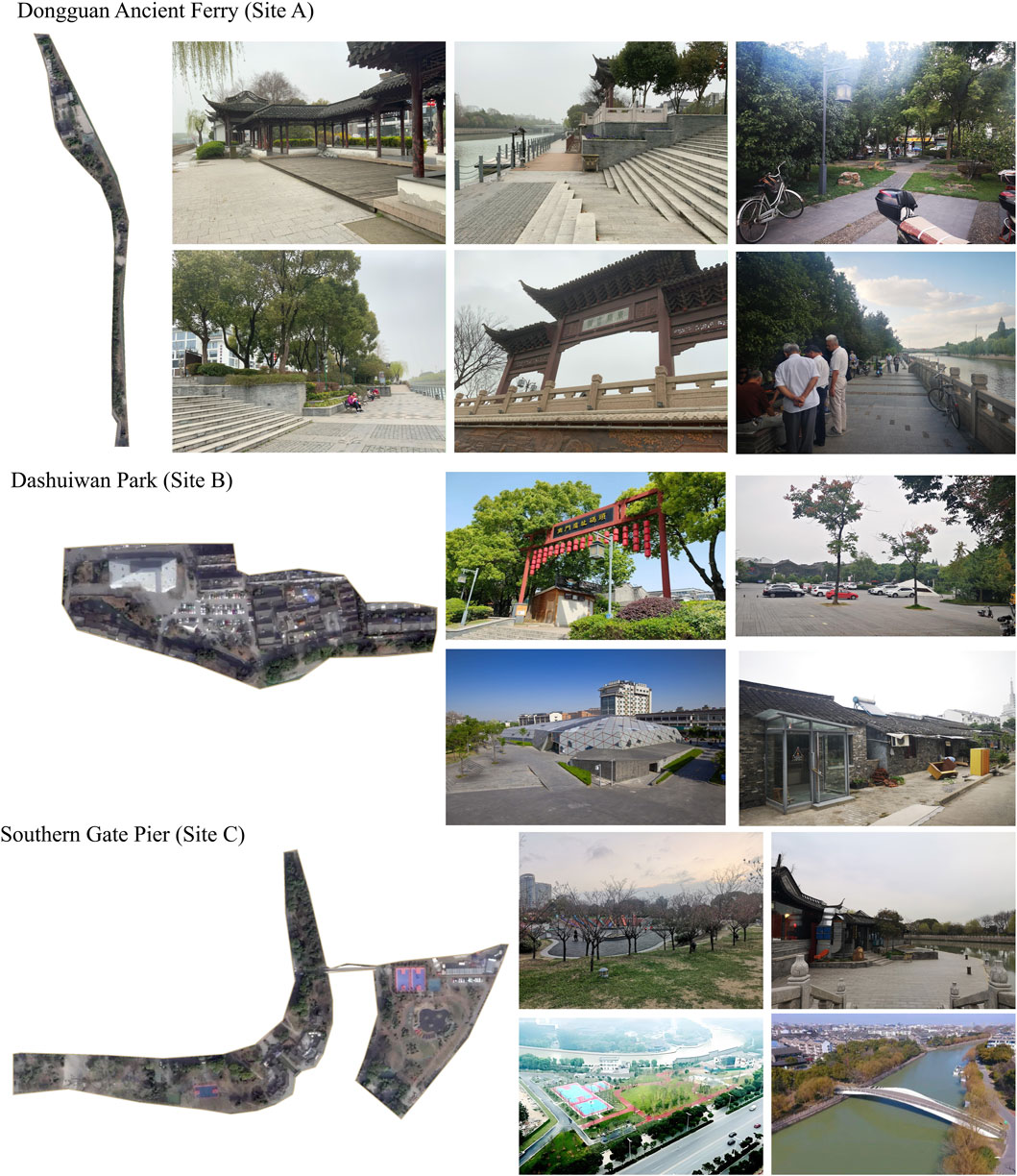
Figure 7. Survey responses on frequency of issues and activities associated with urban canal spaces.
The frequency of visits to the areas surrounding the ancient canal primarily falls into two categories: “daily or almost daily” and “once or twice a week,” accounting for 23% and 24.88% of responses, respectively. Additionally, the option “rarely” is notably high, at 25.35%, indicating that while a significant portion of visitors may be residents living nearby or individuals with specific work or activities necessitating frequent visits, there is also a considerable group that seldom visits the area. The most popular time for visits is between 18:00–20:00, chosen by 49.77% of participants, followed by 16:00–18:00 (14.08%) and 8:00–12:00 (12.68%). In contrast, the time slots of 12:00–14:00 and after 22:00 are less favored, with only 1.41% and 0.47% opting for these times, respectively, suggesting a preference for evening visits to the canal’s surroundings. The duration of most visits is relatively short, with only 3.29% staying for more than 3 hours.
The 30–60-min range is the most popular, garnering 48.36% of responses. Shorter durations (less than 30 min and 30–60 min combined) account for 72.77% of the total, indicating that the majority engage in brief visits or sightseeing. A stay of 1–2 h is preferred by 20.19% of visitors, suggesting some interest in longer engagement, whereas durations exceeding 2 hours are less common, implying that attractions and activities in the vicinity of the ancient canal may not be sufficient to encourage extended stays.
The visitation patterns to the ancient canal’s surrounding areas indicate a preference for frequent, short-duration visits, primarily in the evening. Due to the limited attractions and activities available, a significant portion of visitors engage in brief sightseeing or other activities.
The majority of respondents (81.69%) find accessing the area surrounding the ancient canal very convenient, likely due to direct public transport or the feasibility of reaching the destination by walking, e-bike, or bicycle. A smaller portion, 11.27%, considers the accessibility to be moderately convenient, requiring a transfer, while only 7.04% perceive it as inconvenient, necessitating multiple transfers, or involving excessive travel time.
Walking is the most popular way to reach the canal, accounting for 42.25% of responses. A significant proportion also use private cars, bicycles, and e-bikes, with respective percentages of 29.11%, 30.52%, and 27.23%. Figure 6B illustrates that within roughly 2 km, people are more inclined to arrive on foot. Although public transportation is not the most chosen option, it still serves 46 individuals, indicating its relevance in the mix of transportation methods to the canal. Taxi services and other modes of transport are least preferred, at merely 1.41% and 2.35% respectively.
Regarding parking near the canal, most respondents report finding a parking space within 10 min or between 10 and 20 min, representing 38.5% and 27.7% of responses, respectively. The time spent searching for parking for 20–30 min and over 30 min is less common, at 8.45% and 4.69%, respectively. Additionally, 6.1% of participants report being unable to find parking at all. Furthermore, 31 respondents did not specify their choice, making up 14.55% of the total.
In general, the frequency of visiting the canal spaces is positively correlated to the distance between the canal and residences, but not strongly. Namely, people who live near the canal visit more frequently than those who live further away. Most of those who live close to the canal visit every day, with several special samples showing that even those who live far away also visit the canal with a high frequency.
When visiting the ancient canal, the most common companionship choice is family, accounting for 72.77% of the instances, followed by solo visits at 35.68%, outings with friends at 33.33%, and visits with colleagues or classmates at 9.86%. The preference for visiting with a significant other or partner is relatively low at 4.69% and encounters with strangers are the least common, at 1.41%.
More than half of the respondents (55.4%) occasionally encounter acquaintances 1–2 times around the canal, while 23.94% often meet people they know. Only 7.51% almost always meet acquaintances during their visits, whereas 13.15% have never experienced this.
In terms of social connections in the vicinity of the ancient canal, 87 people (40.85%) reported knowing friends there, whereas 126 individuals (59.15%) said their friends were not from the area. A total of 105 respondents (49.3%) believe that the ancient canal could or would improve social activities. In contrast, 42 individuals (19.7%) think it would not or cannot enhance social interactions. Additionally, 66 respondents (31%) are unsure about the canal’s potential to improve social activities.
Besides, the questionnaire survey results show activities around the ancient canal predominantly include walking, sightseeing, and solitary relaxation. Walking emerges as the most prevalent activity, constituting 59.62% of all recorded instances. Sightseeing follows closely, accounting for 58.22% of activities. Solitary relaxation also ranks highly among the activities, representing 35.21% of the total. Other common activities include pausing to linger at 25.35%, socializing with friends at 15.96%, and dining at 16.9%. Activities such as shopping, square dancing, fishing, playing with pets, participating in cultural and entertainment events or watching performances, fulfilling basic living needs, and other activities are less frequently engaged in by visitors to the canal area.
4.2 The results of observation
Based on the respondents’ preferences (Figure 4) and the controversies surrounding the utilization of Dongguan Ancient Ferry (Site A), Dashuiwan Park (Site B), and Southern Gate Pier (Site C), a focused observational study was conducted to scrutinize the behavioral activities (see Figures 8, 9) within these sites (Figure 10). The outcomes of this research underscore significant distinctions in activity patterns, engagement levels, and site-specific preferences that align with or challenge public sentiment.

Figure 10. Comparative analysis of 2-h activity patterns in three different locations: population counts and activity types.
At Dongguan Ancient Ferry (Site A), “playing card/chess” emerged as the predominant activity, registering a total of 159 instances, primarily concentrated in the peak leisure hours of 14:00–16:00 and 16:00–18:00. This suggests a strong cultural or communal inclination towards stationary, social activities within this historic locale. Additionally, “walking” stood out as the second most frequent activity, with 53 occurrences mainly in the 16:00–18:00 period, highlighting the site’s role as a popular promenade area for residents. Contrastingly, Dashuiwan Park (Site B) presented a markedly different activity landscape, with “dancing” recording the highest activity count at 228, notably during the early morning (06:00–08:00) and late evening (18:00–20:00) hours. This pattern reflects the park’s appeal as a vibrant community hub for physical exercise and social interaction. “Interacting with onsite facilities” also saw significant engagement, with 162 instances primarily in the mid-afternoon to early evening, indicating the park’s well-equipped environment supports a wide range of recreational pursuits. Southern Gate Pier (Site C), however, exhibited a more subdued activity profile with a mere 24 recorded activities, equally split between “standing” and “walking”. This site’s stark scarcity of diverse activities suggests potential underutilization or a lack of amenities conducive to broader recreational or social engagement. This observation points towards a possible misalignment between public preference and the site’s current capacity to fulfill those expectations.
Overall, the total activity count across all sites peaks at 1,315, with “playing card/chess” (303), “dancing” (270), and “interacting with onsite facilities” (163) being the most prevalent activities. The data indicates that active pursuits such as “dancing” and “playing sports” are more common in the early mornings and late evenings, while more stationary activities like “playing cards/chess” dominate the afternoon hours. This pattern underscores the influence of daily schedules on the selection and timing of recreational activities.
5 Discussion
The study explored the shift from the so-called experience economy to the transformation economy, placing emphasis on transformative technologies in architecture and urban design. The integration of results from both quantitative surveys and qualitative observations offers a nuanced view of the canal’s role in enhancing urban greenery and historical appreciation, which aligns with the quantitative findings indicating high resident satisfaction. Qualitative data provide deeper insights into how these elements foster a sense of community and personal wellbeing among users. To more deeply connect these findings to existing urban design theories, this study draws upon principles of transformative and participatory design. The analysis shows that the Yangzhou Canal does more than beautify the city—it acts as a catalyst for social and cognitive transformations, echoing the ‘extended mind’ concept in environmental psychology. This theoretical linkage supports the canal’s role as a vital component in sustainable urban development and participatory design practices, underscoring the importance of integrating cognitive and social functions in urban planning. Besides, this approach interacts organically with people to promote positive changes and uses urban design and the concept of the extended mind in architecture and environmental psychology to study the interplay between individuals and the built environment and to improve the quality of life.
By employing Spearman rank correlation analysis, the study meticulously assesses the correlation between various factors highlighted in the questionnaires and the multifaceted relationships that residents of Yangzhou maintain with the ancient canal. The results show that the Canal, with its rich historical context and public spaces, serves not just as a backdrop to daily life but also plays an active part in shaping cognitive experiences and facilitating wellbeing. In light of the extended mind theory, our findings underscore the canal’s capacity to act as a cognitive extension for its residents.
The spatial configuration, accessibility, and aesthetic qualities of the canal and its surroundings engage the senses, support memory functions, and foster social interactions, all of which are central to cognitive processing and emotional wellbeing. These elements of design do not merely accommodate cognitive activities but enhance and extend them, embodying the essence of the extended mind concept. Thus, the canal’s design can be viewed as a field of cognitive architecture, where the environment actively participates in and supports the cognitive lives of its inhabitants.
Furthermore, the integration of environmental psychology into our analysis reveals how the canal’s characteristics influence residents’ behavior, emotions, and overall satisfaction. This alignment with environmental psychology underscores the canal’s role in extending the cognitive and emotional experiences of its residents, thereby supporting the notion that our environments contribute to our mental processes. The canal enriches the cognitive and emotional landscape of Yangzhou’s urban life by fostering a sense of community, enhancing the appreciation of cultural heritage, and providing spaces for relaxation and socialization.
This discussion further highlights the complex dynamics of how gender and age influence engagement and social interactions around the ancient canal, the elements promoting social interactions, and further methodological questions.
5.1 Gender and age disparities
As Hajialiakbari et al. (2022) found in their study on Tehran, the type of activities in space is related to different groups population. Field observations revealed a significant relationship between the activities within the site and the demographic attributes of age and gender. Consequently, a correlation analysis of survey data concerning age and gender was conducted, as shown in (Table 4, to identify if different demographics have specific preferences. Notably, a significant negative correlation between gender and visit frequency suggests a divergence in how often females visit the canal compared to males. This pattern aligns with observations indicating males are more likely to engage in social activities like playing chess or cards (Wang et al., 2022), potentially leading to more acquaintance encounters. On the age front, the analysis revealed elder individuals spend more time per visit, reflecting the observational data that older visitors are more inclined towards activities that allow for prolonged engagement. The positive correlation between age and encountering acquaintances further underscores the canal’s role in fostering social ties among older adults. Interestingly, square dancing exhibits a significant positive correlation with both gender and age, indicating its appeal to older females and suggesting activities like these could be pivotal in community engagement (Cooper and Thomas, 2002; Qu et al., 2023). Additionally, research indicates that square dancing participation and group belonging positively impact the subjective wellbeing of Chinese empty-nest women, while family cohesion also enhances their happiness (Xie et al., 2020) The use of electric bicycles showed a distinctive preference among younger demographics and females, adding another layer to the nuanced understanding of public space usage (Fishman et al., 2013).
5.2 What promotes social interaction
Urban canal spaces as green common spaces play crucial roles in fostering social interactions among citizens and promoting community engagement and connectivity (Kweon et al., 1998; Oldenburg, 1989; Smith et al., 2020). The analysis, depicted in (Table 5), demonstrates statistically significant relationships between these aspects of social interactions and variables such as frequency of visits, accessibility, and participation in specific activities like square dancing, fishing, and other sports and entertainment performances.
The negative correlation between making friends and the frequency of visits suggests that frequent visits to the ancient canal are not directly related to making new friends. Conversely, the positive correlation between encounters with acquaintances, frequency of visits, and average length of stay highlights the importance that canals can have for community cohesion. Additionally, it was also found that the convenience of transportation is negatively correlated with the chance of meeting acquaintances, which is contrary to common sense but also proves that even if transportation is inconvenient, people still have the opportunity to meet acquaintances in the canal area. Square dancing, fishing, and other sports positively impact social activities, and the first two are also favorite activities among the elderly. These activities strengthen social connections within the community (Brown et al., 2003).
5.3 Basis of research methods
Previous results reveal the disparities between questionnaire and on-site observational results, which underscored differences in the methodologies employed in studying activities. The questionnaire may be influenced by biases such as memory distortions and individual predispositions. In contrast, on-site observational methods afford a more immediate and present depiction of behaviors, providing a direct lens into the dynamics of urban engagement (Whyte, 1980). These methods, however, possess their observable during the research period. Furthermore, variances in the demographic composition of respondents between the two methodologies may amplify observed disparities, as the cohort engaging with questionnaires might not accurately mirror the demographic profile of individuals present within the site of observation. Consequently, in the realm of activity research, a predilection towards on-site observational studies is advocated, given their enhanced capacity to yield veritable insights into the extant behaviors and interaction patterns within urban settings (Charmaz, 2006).
6 Conclusion and recommendations
This study provides a detailed examination of the transformative role of urban public spaces, focusing specifically on the Ancient Canal of Yangzhou. Employing questionnaires combined with extensive field observations and GIS mapping, it investigates the canal’s influence on fostering social interactions, community engagement, and enhancing residents’ quality of life.
The novelty of this study lies in its focused application of GIS and environmental psychology to the Ancient Canal of Yangzhou, providing a detailed case study on the impact of such integration on urban space utility and resident satisfaction. Unlike broader applications often seen in river or canal space studies, this research offers a nuanced analysis of how historical canals influence urban life, specifically examining the socio-psychological impacts on residents. This detailed local context application contributes new insights into the relationship between residents and their historic urban environments, demonstrating how specific historical urban features can be leveraged to enhance community engagement and quality of life. This focused approach provides a valuable template for similar studies in other historical urban settings, highlighting specific socio-psychological dynamics that might be overlooked in more general studies.
This study’s contributions are multifaceted. It expands the scope of urban design theory by demonstrating how historical urban spaces like the Ancient Canal of Yangzhou can be actively integrated into cities’ sustainability and livability strategies. Furthermore, it provides empirical evidence of the cognitive and social benefits derived from well-designed public spaces. This study also offers a model for other researchers and urban planners on how to incorporate cultural heritage into contemporary urban planning to enhance social sustainability and resident wellbeing.
From a policy perspective, the results emphasize the need for policies that both preserve and enhance the functionality of historical urban waterways. By showcasing the Ancient Canal of Yangzhou as a catalyst for community cohesion and individual wellbeing, the study advocates for urban policies that leverage transformative technologies for better planning and management of urban blue-green spaces. Policymakers are encouraged to integrate these historical waterways into the broader urban environment effectively. This integration should focus on improving accessibility, adding leisure facilities, and valorizing cultural heritage, which collectively contribute to creating a built environment that supports cognitive extension in urban contexts.
The study is limited by its focus on one specific urban setting—Yangzhou—and the scale of the sample size, which may affect the generalizability of the findings. This indicates a need for further research involving larger and more diverse urban settings to confirm the findings and refine the proposed strategies. Future research should consider conducting comparative studies across multiple cities to understand the universal applicability of the findings and to refine urban planning strategies to make them more adaptable and broadly effective.
In conclusion, this study reinforces the importance of integrating cognitive and social sciences into urban design practices. It highlights how well-planned public spaces can significantly enhance the daily lives of residents and contribute to the sustainable development of urban areas. The Ancient Canal of Yangzhou serves as a prime example of how thoughtful integration of historical elements into contemporary urban planning can enrich urban life, offering a roadmap for future endeavors in urban design.
Data availability statement
The raw data supporting the conclusion of this article will be made available by the authors, without undue reservation.
Author contributions
DF: Methodology, Writing–review and editing, Writing–original draft, Supervision, Conceptualization. SM: Resources, Writing–review and editing, Writing–original draft, Visualization, Software, Methodology, Investigation, Formal Analysis, Data curation, Conceptualization. GC: Writing–review and editing, Writing–original draft.
Funding
The author(s) declare that no financial support was received for the research, authorship, and/or publication of this article.
Conflict of interest
The authors declare that the research was conducted in the absence of any commercial or financial relationships that could be construed as a potential conflict of interest.
Publisher’s note
All claims expressed in this article are solely those of the authors and do not necessarily represent those of their affiliated organizations, or those of the publisher, the editors and the reviewers. Any product that may be evaluated in this article, or claim that may be made by its manufacturer, is not guaranteed or endorsed by the publisher.
References
Abdulla, K., and Abdelmonem, M. G. (2023). Mapping safety, security and walkability of historical public open spaces in post-conflict Libya: tripoli as north african case study. J. Contemp. Urban Aff. 7, 85–105. doi:10.25034/ijcua.2023.v7n2-6
Brown, C., Lloyd, K., and Murray, S. (2003). The urban park: oasis or desert for the elderly? J. Aging Stud. 17, 435–448. doi:10.1016/j.jaging.2003.07.001
Carù, A., and Cova, B. (2003). Esperienze di consumo e marketing esperienziale: radici diverse e convergenze possibili. Micro and Macro Mark. J. 12, 187–212. doi:10.1431/9503:y:2003:i:2:p:187-212
Charmaz, K. (2006). Constructing grounded theory: a practical guide through qualitative analysis. Sage. doi:10.4135/9781849209236
Clark, A., and Chalmers, D. J. (1998). The extended mind. Analysis J. 58, 7–19. doi:10.1093/analys/58.1.7
Cooper, L., and Thomas, H. (2002). Growing old gracefully: social dance in the third age. Ageing Soc. 22, 689–708. doi:10.1017/S0144686X02008929
de Magalhães, C., and Carmona, M. (2009). Dimensions and models of contemporary public space management in England. J. Environ. Plan. Manag. 52, 111–129. doi:10.1080/09640560802504704
Fanzini, D., and Venturini, G. (2022). “Intervention on the built environment: approaches and strategies for the city,” in Reactivation of the built environment: from theory to practice (Springer), 1–14.
Fishman, E., Böcker, L., and Helbich, M. (2013). Adult active transport in The Netherlands: an analysis of its contribution to physical activity requirements. PLoS One 10, e0121871. doi:10.1371/journal.pone.0121871
Gaggioli, A., Cipresso, P., Serino, S., Campanaro, D. M., Pallavicini, F., Wiederhold, B. K., et al. (2014). Positive technology: a free mobile platform for the self-management of psychological stress. Stud. Health Technol. Inf. 199, 25–29. doi:10.3233/978-1-61499-401-5-25
Hajialiakbari, K., Zare, M., and Karimi, M. (2022). The role of “scale” on the acceleration of social interaction in urban spaces. J. Contemp. Urban Aff. 6, 59–68. doi:10.25034/ijcua.2022.v6n1-6
Haruna, P. B., Zubairu, S., Olagunju, R. E., and Akande, O. K. (2023). Liveability considerations: towards designing sustainable public housing in Niger state, Nigeria. J. Contemp. Urban Aff. 7, 262–278. doi:10.25034/ijcua.2023.v7n2-16
Kaymaz, I. (2013). “Urban landscapes and identity,” in Advances in landscape architecture (Rijeka: IntechOpen). doi:10.5772/55754
Kweon, B., Sullivan, W., and Wiley, A. (1998). Green common spaces and the social integration of inner-city older adults. Environ. Behav. 30, 832–858. doi:10.1177/001391659803000605
Lin, H., Cooke, S., Wolter, C., Young, N., and Bennett, J. (2020). On the conservation value of historic canals for aquatic ecosystems. Biol. Conserv. 251, 108764. doi:10.1016/j.biocon.2020.108764
Lynch, K. (1964). The image of the city. MIT Press. Available at: https://books.google.co.jp/books?id=_phRPWsSpAgC.
Nicholls, S., and Crompton, J. L. (2017). The effect of rivers, streams, and canals on property values. River Res. Appl. 33, 1377–1386. doi:10.1002/rra.3197
Oldenburg, R. (1989). The great good place: cafés, coffee shops, community centers, beauty parlors, general stores, bars, hangouts, and how they get you through the day. New York: Paragon House.
Ostanel, E. (2018). Spazi fuori dal comune: rigenerare, includere, rinnovare. Milano: Franco Angeli.
Papanek, V. (1972). Design for the real world. New York: Bantam Books. Available at: https://monoskop.org/images/f/f8/Papanek_Victor_Design_for_the_Real_World.pdf.
Pine, B. J., and Gilmore, J. H. (1999). The experience economy: work is theatre and every business a stage. Boston, MA: Harvard Business Press. doi:10.1017/CBO9781107415324.004
Qu, Y., Liu, Z., Wang, Y., Chang, L., and Fan, H. (2023). Relationships among square dance, group cohesion, perceived social support, and psychological capital in 2721 middle-aged and older adults in China. Healthcare-basel 11, 2025. doi:10.3390/healthcare11142025
Schmitt, B. H. (1999). Experiential marketing. New York: The Free Press. doi:10.1362/026725799784870496
Smith, A., Lee, D., Davidson, M. J., Berbés-Blázquez, M., Georgescu, M., Krayenhoff, E. S., et al. (2020). The co-production of sustainable future scenarios. Landsc. Urban Plan. 197, 103744. doi:10.1016/j.landurbplan.2020.103744
Tsukada, S., Morita, T., Hashimoto, T., and Yuzawa, A. (2014). Environmental value assessment of historical irrigation canals in urbanized areas: the case of tenguiwa irrigation canal in maebashi. doi:10.5632/jilaonline.7.141
Ujang, N. (2012). Place attachment and continuity of urban place identity. Procedia-Social Behav. Sci. 49, 156–167. doi:10.1016/j.sbspro.2012.07.014
U.N.E.S.C.O. (2011). Recommendation on the historic urban landscape. Available at: https://whc.unesco.org/uploads/activities/documents/activity-638-98.pdf.
Vaeztavakoli, A., Lak, A., and Yigitcanlar, T. (2018). Blue and green spaces as therapeutic landscapes: health effects of urban water canal areas of isfahan. Sustainability-basel 10, 4010. doi:10.3390/su10114010
Wang, J., Liu, N., and Zhao, X. (2022). Association of playing cards or mahjong with cognitive function in Chinese older adults. Int. J. Environ. Res. Public Health 19, 9249. doi:10.3390/ijerph19159249
Whyte, W. H. (1980). The social life of small urban spaces. Washington, DC: Conservation Foundation.
Keywords: transformative technologies, transformative architecture, resident satisfaction, public space, urban canal space, environmental psychology, neuro-architecture
Citation: Fanzini D, Miao S and Casoni G (2024) Methods and instruments for the transformative design of the public space: insight from the Ancient Canal of Yangzhou in China. Front. Built Environ. 10:1408827. doi: 10.3389/fbuil.2024.1408827
Received: 29 March 2024; Accepted: 03 June 2024;
Published: 11 July 2024.
Edited by:
Pier Luigi Sacco, University of Studies G. d'Annunzio Chieti and Pescara, ItalyCopyright © 2024 Fanzini, Miao and Casoni. This is an open-access article distributed under the terms of the Creative Commons Attribution License (CC BY). The use, distribution or reproduction in other forums is permitted, provided the original author(s) and the copyright owner(s) are credited and that the original publication in this journal is cited, in accordance with accepted academic practice. No use, distribution or reproduction is permitted which does not comply with these terms.
*Correspondence: Daniele Fanzini, ZGFuaWVsZS5mYW56aW5pIEBwb2xpbWkuaXQ=; Siqi Miao, c2lxaS5taWFvQHBvbGltaS5pdA==
 Daniele Fanzini
Daniele Fanzini Siqi Miao
Siqi Miao Giorgio Casoni
Giorgio Casoni